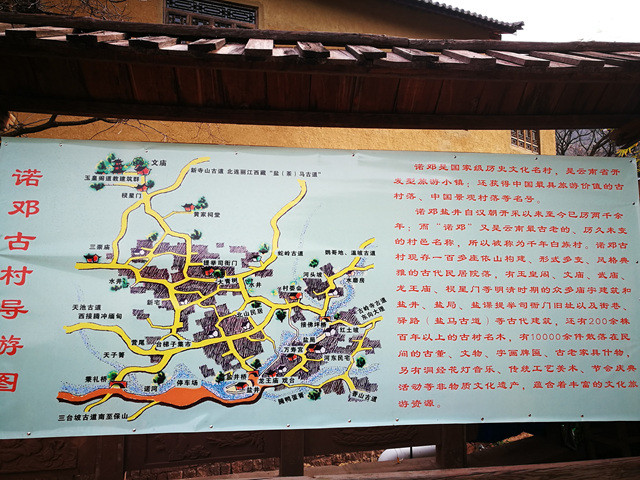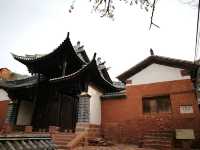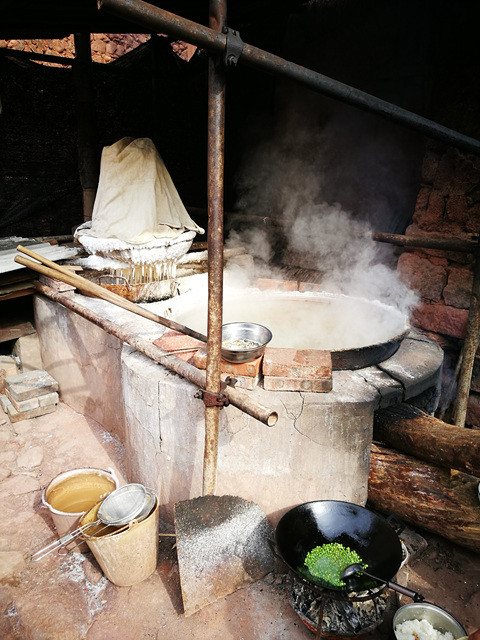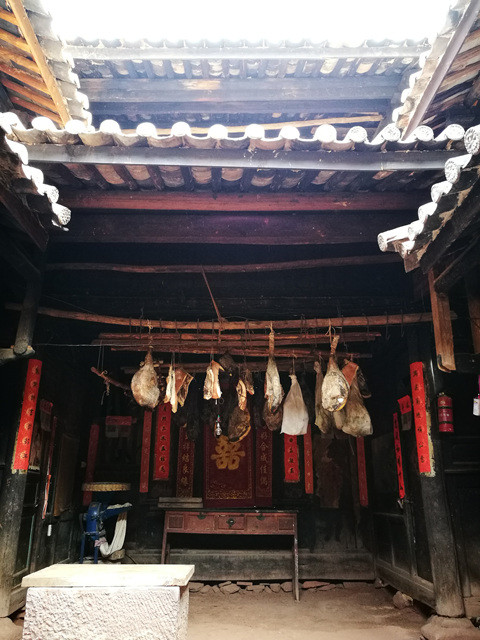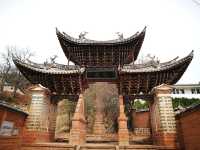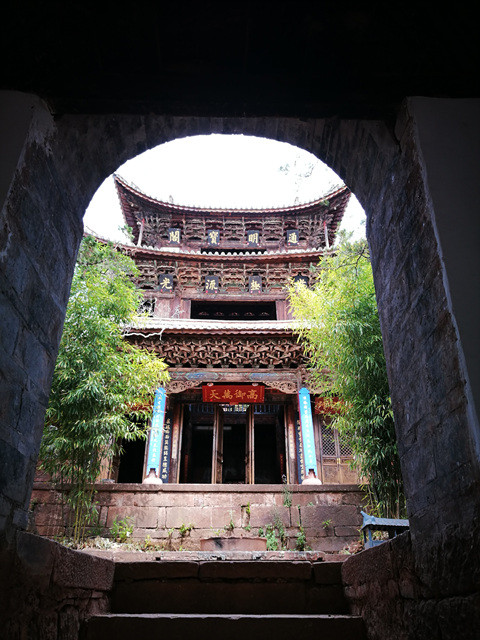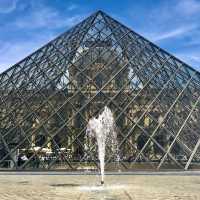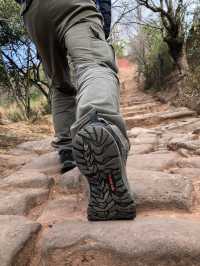The 2 lanes of the road from Yunlong County to Norden Village are in good condition, and only a few kilometers will soon arrive at the free parking lot at the foot of the village mouth hill. It is said that it was very difficult to walk when the road was not built before. Norden is the oldest village name in Yunnan province that has remained unchanged for more than a thousand years. It means "the slopes with tigers" in Bai language. Because the salt industry flourished for a while, then declined, because China on the tip of the tongue came back to people's sight. This small village, which was found in historical records and experienced the dynasties of Tang, Song, Yuan, Ming and Qing dynasties for 1138 years, was a great place in ancient times. In the Tang Dynasty "Manshu" there was a clear record of Norden, which had been digging wells to make salt at the latest in the Tang Dynasty. It was a typical village which relied on salt wells for its survival. Inoden salt is extraordinary, Baoshan, Tengchong area has been very fond of eating "Noble Salt" since ancient times. In ancient times, Norden's "Tea Horse Road" went east to Kunming, Dali, south to Tengchong, Baoshan, West to Liukupima, north to Lanping Lijiang, where businessmen from all directions gathered and prospered. Norden Village once became one of the commercial centers in Western Yunnan. The ancient salt wells in the village, as well as the old sites of Ming Dynasty Wujing Salt Course Tiju Yamen, Wenwu Temple, Weixing Gate and Yuhuangge Pavilion, are well preserved. At present, the ancient village style and many ancient buildings of Ming and Qing Dynasties over a hundred years are quite intact in their original state, which are very rare in Yunnan and even in China. Entering the village, the first one on the left hand side of the river crossing is the one that has taken the tip of the farmhouse. After the tourists come in a rush, it is not easy to find the real Nuo Deng ham now. The farmers in remote areas can raise several pigs, and ham is a product that needs time to precipitate. Ham bought outside is sold to tourists as local ham. People with golden eyes can buy it. If they are inexperienced, they should not be fooled by money. The villages are all along the Shibanshan Road, and the transportation of goods still depends on horses and mules. Therefore, if you want to stay in the village inn, you'd better pack it lightly and simply. Although the owner can bring animals to help carry luggage, it's really hard to go up the mountain. Instead of crossing the river and climbing the mountain, we went straight to the east of the river to visit the Salt Museum in front of us. It's good to know the history of salt industry's rise and fall, and the introduction of scenic spots in the village. The chimney in the courtyard is an ancient relic left over from boiling salt. Behind the Salt Museum is the Dragon King Temple. It is said that the Dragon King of Norden managed the five wells of Yunlong. Unfortunately, the door of the temple was closed and it was not allowed to enter. The Longevity Palace site is the oldest building in the village. In the early Ming Dynasty, people changed the Guild Hall of Jiangxi Province into a temple, called "Zhushou Temple". During Jiajing period, Li Qiong was cited to rebuild the temple, which was not renamed "Longevity Palace" in Ming Dynasty. The same is the door locked, not allowed to enter, asked the villagers that no one at home, not to enter a good regret. Yanjie Salt Bureau, the government has nowhere to look for, only this sign marking the location. In ancient times, salt cookers handed over the salt to salt bureaus. Salt officers distributed the salt to all parts of the country for marketing. An endless stream of salt horse gangs set out here, heading east to Dali, south to Baoshan, West to Tengchong, Myanmar, north to Lijiang and Tibet on the "Salt (Tea) Ma Gudao".
諾鄧古村評價
4.8 /5291條評價
諾鄧古村常見問題
更多相關問題
熱門目的地
熱門目的地的推薦景點
深圳的附近景點 | 台北的附近景點 | 東京的附近景點 | 香港的附近景點 | 大阪的附近景點 | 曼谷的附近景點 | 澳門的附近景點 | 首爾的附近景點 | 廣州的附近景點 | 珠海的附近景點 | 上海的附近景點 | 倫敦的附近景點 | 福岡的附近景點 | 吉隆坡的附近景點 | 高雄的附近景點 | 新加坡的附近景點 | 北京的附近景點 | 沖繩的附近景點 | 巴黎的附近景點 | 名古屋的附近景點 | 札幌的附近景點 | 台中的附近景點 | 成都的附近景點 | 布吉的附近景點 | 京都的附近景點 | 悉尼的附近景點 | 馬尼拉的附近景點 | 溫哥華的附近景點 | 佛山的附近景點 | 釜山的附近景點
熱門景點
心齋橋 | 香港故宮文化博物館 | 珠江夜遊 | SGP卡丁車俱樂部 | 2024 周華健 少年的奇幻之旅演唱會-澳門站 | 螢火蟲水洞 | 愛寶樂園 | 祇園 | 幻多奇樂園 | 香港海洋公園 | 北京環球度假區 | 梵高星空藝術館(珠海旗艦店) | 玉龍雪山 | 暹羅古城 | 天山神祕大峽谷 | 大唐不夜城 | 閣蘭島 | 台場 | Masjid At Taqwa | Rana Park | Masjid AL BARKAH | Youpla Land | Ploshchadka Dlya Vygula Sobak | Sun River Veterans Memorial Park | Wapsipinicon State Park Rotary Lodge | Ballparks National | Red Tail Golf Club | The Saint Louis University Museum of Art | 東京塔 | 塔龍加動物園
熱門遊記
熱門排行榜
岷縣附近的熱門親子景點 | 英山附近的熱門親子景點 | 綏化附近的熱門親子景點 | 錫拉庫扎6大豪華酒店 | 基蒂萊附近的熱門奢華酒店 | 阿爾山附近的熱門親子景點 | 長沙12大高級餐廳 | 科倫坡10大酒吧 | 哈爾濱5大高級餐廳 | 貝加莫附近的熱門奢華酒店 | Avudangawa附近的熱門奢華酒店 | 陸良附近的熱門親子景點 | 維斯拉的熱門豪華酒店 | 鶴崗附近的熱門親子景點 | 聖彼得港附近的熱門奢華酒店 | 塞薩里烏蘭日附近的熱門奢華酒店 | 仙本那4大酒吧 | 南岔附近的熱門親子景點 | 南京24大高級餐廳 | 海爾茲利亞的熱門奢華酒店 | 東京19大夜間景點 | 曼谷10大夜間景點 | 首爾11大夜間景點 | 澳門12大夜間景點 | 多倫多的熱門夜間景點 | 三藩市的熱門夜間景點 | 羅馬的熱門夜間景點 | 峇里島的熱門夜間景點 | 布吉的熱門夜間景點 | 清邁的熱門夜間景點

